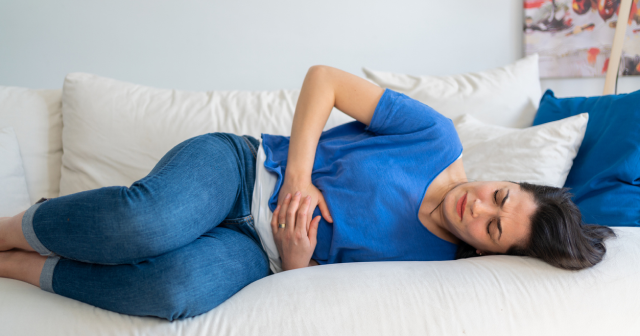Menopause and mood swings
The time of your life when you stop having periods is known as the menopause. It’s a natural part of getting older, but it can cause various symptoms, including mood swings.
Mood swings are when you have a sudden change in mood – from low to high, or the other way round. They’re common in menopause and the time leading up to it (perimenopause). You may find yourself suddenly feeling angry, upset or irritable for no obvious reason.
Let’s look at why menopause mood swings happen, when to see a doctor, and what treatments are available to help you feel better.
How does the menopause affect your mood?
Like other menopause symptoms, mood swings can be caused by lower levels of the hormones oestrogen and progesterone in your body.
You can get perimenopause mood swings for the same reason. This is the time leading up to menopause, when your periods become less regular and your hormone levels start to change.
As your oestrogen and progesterone drop, so do your levels of serotonin – a brain chemical that can give you feelings of happiness and wellbeing. This lack of serotonin can play a part in mood swings and feelings such as irritability, worry and sadness.
Mood swings can also be a side effect of other symptoms of perimenopause and menopause, such as hot flushes, vaginal dryness, joint pain and dizziness. For example, hot flushes at night (night sweats) may be stopping you from sleeping, or vaginal dryness or loss of sex drive (libido) may be affecting your sex life.
Reaching the menopause also means you’re no longer able to get pregnant, which may affect how you feel emotionally.
Major life changes that can happen around this time can also play a part in mood swings, such as health issues, divorce, children leaving home, or parents getting older or dying.
As well as mood swings, anxiety during menopause is also common. Read more about unusual menopause symptoms.
Menopause and depression
Symptoms such as mood changes and anxiety can sometimes be confused with depression. This is a more serious condition where you feel low in mood most of the time, for weeks or months rather than days.
Your risk of depression can increase around the perimenopause and menopause, especially if you’ve had depression in the past.
Extra life pressures, such as those mentioned above, can also increase your chances of depression.
Symptoms of depression include having a constant low mood, feeling tearful or hopeless, and not wanting to do things you used to enjoy.
If you have these symptoms most of the time, or think you may have menopause depression, speak to your doctor.
When to see a doctor
You should call an ambulance if you’re having a mental health emergency – such as if you’ve seriously hurt yourself, or you feel like hurting yourself. Read more about suicide support.
You should see a doctor if you have menopause mood swings and:
- you’ve had low mood for more than 2 weeks
- the things you’re trying aren’t helping
- it’s affecting your quality of life
- you feel you’re not coping with your mood
- you’d like a referral for therapy
What can help with menopause mood swings?
There are a few treatment options for menopause mood swings, ranging from medication and therapy to lifestyle changes and self-care techniques.
Hormone replacement therapy (HRT)
Hormone replacement therapy (HRT) is commonly used to reduce menopause symptoms, including mood swings. It works by replacing the hormones you start making less of in the perimenopause.
Most people on HRT take a combination of oestrogen and progestogen (similar to progesterone). If you’ve had your womb removed (hysterectomy), you can have oestrogen-only HRT.

Cognitive behavioural therapy (CBT)
Cognitive behavioural therapy (CBT) is a talking therapy that can help with mental and physical health issues, including low mood and anxiety.
It aims to teach you to deal with problems by breaking them down into smaller parts and thinking about them differently, to help you feel better about them and react in a more positive way.
Your doctor might be able to refer you to a therapist, or you can pay for a private therapist. There are also online courses and apps you can try.
Natural remedies
Some simple lifestyle changes can help with mood swings during menopause.
Exercise and diet
Try to keep active and get some regular exercise. This can help boost your mental wellbeing by raising your levels of endorphins, your body’s ‘feel-good’ chemical.
It’s also a good idea to eat a healthy, balanced diet and avoid too much sugar. Sugary foods cause your blood sugar to quickly rise and then fall, which can make you feel irritable. Try these tips on how to cut down on sugar in your diet.
You may want to consider eating more foods that contain soya, such as soya beans, tofu and soya milk. These contain substances called phytoestrogens, which are similar to oestrogen. It’s thought they may have a similar effect on your body – although evidence for this is limited.

Sleep and relaxation
Lack of sleep can have a big effect on how you feel, leading to irritability and possibly making mood swings worse.
It can be difficult to get a good night’s sleep if you’re dealing with menopause symptoms such as night sweats, but improving your sleep routine may help. Try creating a restful sleeping environment, always going to bed and getting up at the same time, and not using screens for at least 1 hour before bedtime.
Read more tips to improve your quality of sleep.
Relaxing types of exercise, such as yoga and tai chi, can also help mood swings. As well as helping with a good sleep routine, they help to relax your muscles.
Try these breathing exercises for instant calm.
Key takeaways
- mood swings are common in menopause and perimenopause
- they can be triggered by falling hormones or other menopause symptoms
- mood swings can also be caused by life events around this time
- HRT can effectively treat mood swings and other menopause symptoms
- diet, exercise, good sleep and relaxation techniques can also help with your mood
Did this article teach you something new? Try out our 28-day in-app feel happier plan for more tips and hacks on how to feel better. Currently available on iOS only.







